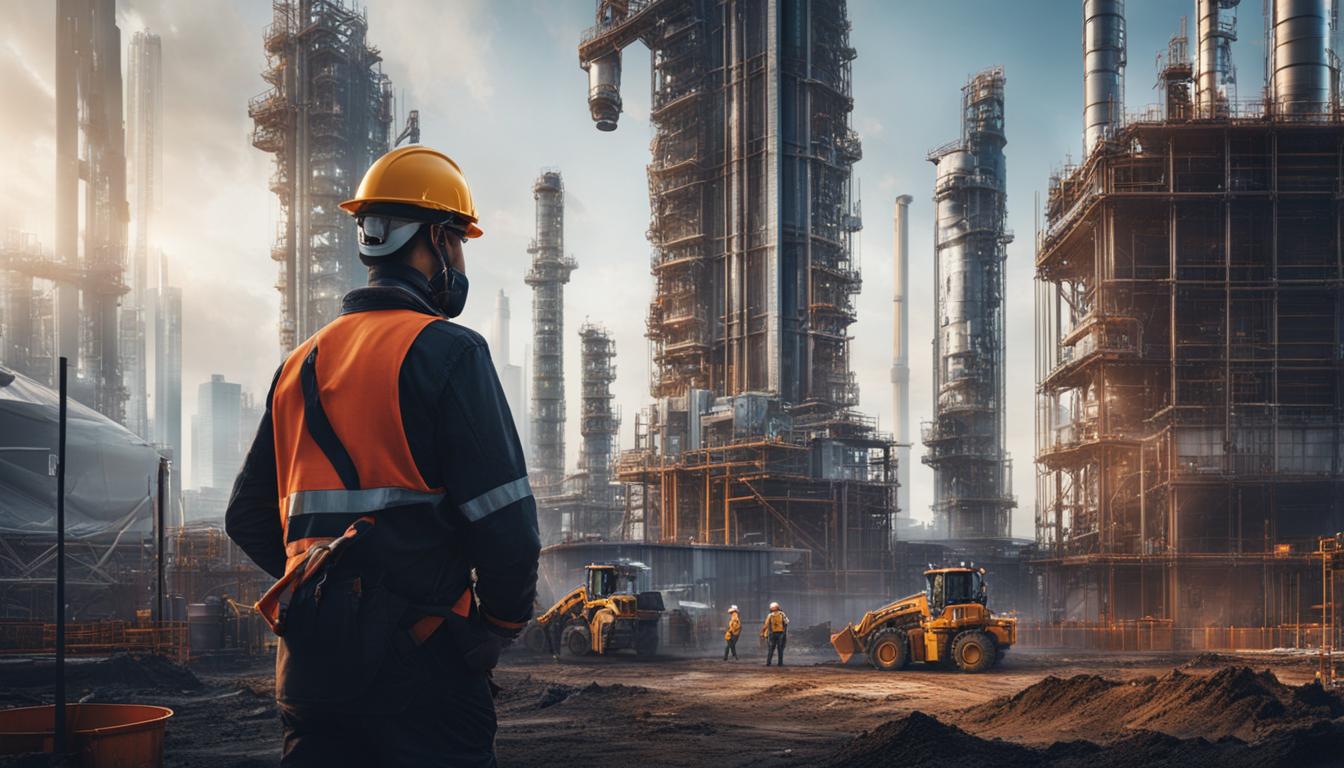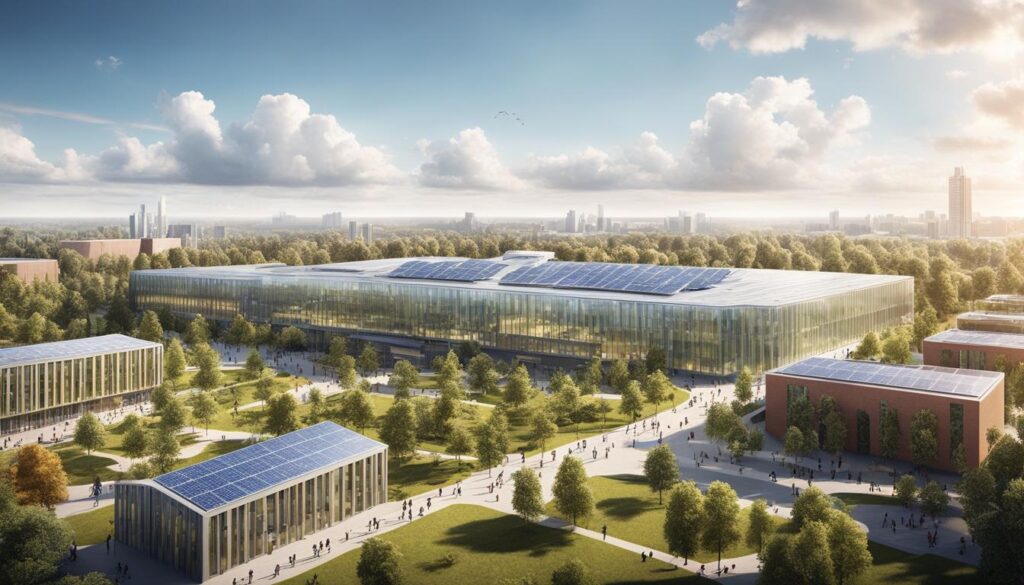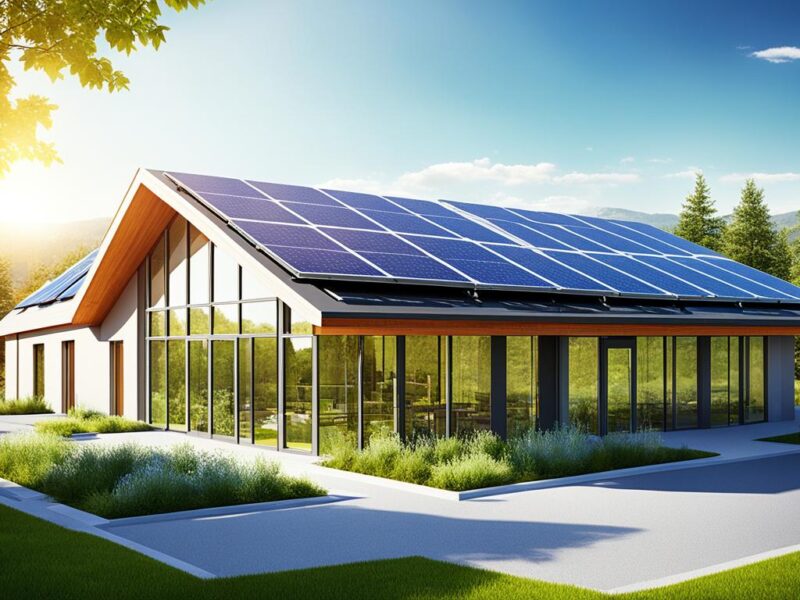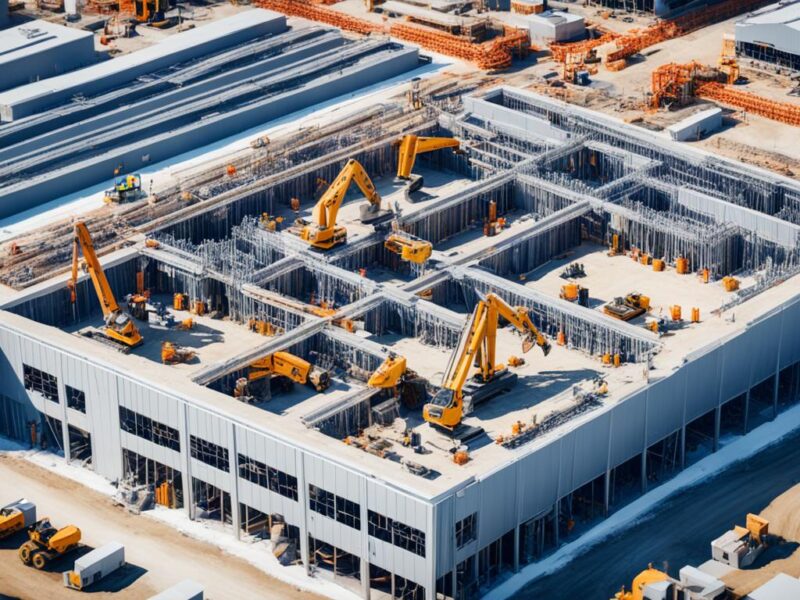
Advancing Construction: Carbon Capture Innovations
The construction industry stands at the forefront of a sustainable revolution, fueled by cutting-edge carbon capture in construction technologies. The U.S. Department of Energy is pioneering this transformation, investing substantially in projects that promise to reduce carbon emissions in robust, eco-friendly construction techniques. As the world inches towards carbon-neutral construction methods, these initiatives serve as pillars in realizing a cleaner, more sustainable future. By fostering sustainable construction solutions, we not only combat the effects of climate change but also embrace an era of innovation within the fundamental bedrock of urban development.
Stay informed on the latest developments in this dynamic field with Modular Pulse, your premier source for construction technology news. Subscribe for free to receive cutting-edge insights and updates directly to your inbox: https://modularpulse.com/subscribe/
Key Takeaways
- DOE’s investment galvanizes carbon capture integration into sustainable building practices.
- Emergent carbon capture solutions are reshaping the construction landscape.
- Innovations pave the way toward achieving carbon neutrality in construction processes.
- Substantial funding underlines the commitment to eco-friendly construction advancement.
- Multifaceted projects emphasize the industry’s capability in utilizing captured carbon effectively.
- The burgeoning field promises economic opportunities in line with ecological stewardship.
Exploring the Role of Carbon Capture in Construction
Climate change poses a monumental challenge to the construction industry, urging a pivot toward more sustainable building practices. In response, carbon capture technology for buildings has emerged as a crucial component in the drive towards an environmentally responsible future. The initiatives lead by the U.S. Department of Energy (DOE) demonstrate a strong interconnection between technological innovation and ecological stewardship.
Capitalizing on the intersection of carbon management and industrial growth, the DOE has strategically directed federal funds to research initiatives that capture and repurpose carbon emissions. These funds are a significant investment in the future of construction, aiming to not only diminish the carbon footprint of building processes but also utilize captured carbon in constructing the future.
Innovative Projects Funded by DOE’s Carbon Management
The DOE’s recent investment of over $13 million in 23 projects underlines a commitment to advance carbon capture technologies. These projects lead the charge, scaling up such technologies to commercial viability and setting a trajectory towards reduced carbon emissions consistent with the construction industry’s role in mitigating climate change.
Commercial Deployment of Carbon Capture Technologies
With an eye on the future, the DOE earmarked $2.5 billion and $2.25 billion for initiatives specifically aimed at bolstering investment in carbon capture, transport, and storage ventures. These investments mark a new era in commercializing carbon capture technologies, presenting a paradigm shift in how the construction industry approaches environmental concerns.
Sustainable Building Materials Created from Captured Carbon
These DOE-funded projects are not simply about reducing emissions—they are transforming them into valuable assets. Carbon emissions captured from industrial facilities are now shaping sustainable materials for construction, leading to the development of eco-friendly concrete and other such innovative building materials that promise lower life cycle emissions and improved performance.
Casting a spotlight on decarbonization efforts, Assistant Secretary of FECM Brad Crabtree vocalized the pivotal role of carbon capture in achieving President Biden’s goal for a net zero economy by 2050. The rapid development and adoption of these technologies are not only environmentally prudent but also have the potential to spawn high-quality job opportunities and economic prosperity domestically.
Strides in Carbon Capture Technology for Buildings
The forward march in carbon capture technology for buildings has opened new doors toward achieving a more sustainable footprint in construction. This drive brings not only a revolution in design and methodology but also harmonizes the building processes with ecological demands. The advancements are vital for implementing green building materials, ushering in a new era where environmental responsibility and industry innovation coincide.
Increasingly, carbon capture in construction is being seen as less of a futuristic notion and more of an immediate imperative. The U.S. Department of Energy recognizes this, propelling the movement with significant support for new technologies that absorb CO2 emissions and integrate them back into valuable construction frameworks. These technologies do not merely reduce emissions—they repurpose them.
A prime example is the transformation of the conventional concrete, a staple in the industry, to integrate carbon capture in its synthesis. What we are witnessing is a shift from the traditional carbon-intensive concrete to newer compositions that are eco-friendlier and have a reduced carbon footprint. Such breakthroughs not only promise a reduction in the industry’s emissions but also a potential enhancement in the material’s performance and durability.
- Carbon capture technologies are significantly altering the construction landscape.
- DOE is fostering advancements that contribute to a substantial carbon footprint reduction.
- New material formulations are expected to yield economic and environmental benefits.
Encouraging this transformation, the DOE’s financial endorsement of research and innovation is intended to foster permanent, long-term changes within the construction industry. Below is a synoptic overview of projects that visualize this financial backbone:
| Project Title | Objective | Funding |
|---|---|---|
| Carbon-Efficient Construction Materials | To develop alternative materials with integrated carbon capture. | DOE Funding Allocated |
| CO2-to-Concrete Conversion | Transforming captured CO2 into concrete applications. | Partial Federal Support |
| Eco-Friendly Cement Synthesis | Creating cement variants with a smaller carbon footprint. | Private and Federal Investment |
With concerted efforts and an unmistakable commitment to incorporating carbon capture into every layer of the construction industry, the resulting green materials are poised to become standard components of tomorrow’s infrastructure. This thrust towards green building materials will indubitably lead to a more sustainable global environment—one where construction and conservation go hand in hand.
DOE’s Commitment to Carbon Reduction in the Construction Industry
The United States Department of Energy (DOE) has exhibited an unwavering commitment to driving sustainable construction solutions and fostering carbon footprint reduction within the construction industry. Acknowledging the critical role of innovation in mitigating climate change, the DOE is investing in carbon capture research and development, ushering in a new age for the construction sector that emphasizes sustainability.
$13 Million Investment in Carbon Capture Research
With an investment surpassing $13 million, the DOE has financed 23 distinctive projects, each poised to make strides in carbon capture technologies. This funding aligns with the nation’s aggressive approach in combatting climate change, while catalyzing a movement that can significantly reshape the ecological impact of future construction practices.
$2.5 Billion Funding in Carbon Capture Initiatives
The DOE’s substantial allocation of $2.5 billion in funding for carbon capture initiatives signifies the scale of its dedication to this cause. These initiatives are integral to the department’s strategy for accelerating the commercial deployment of carbon capture technologies, which will be paramount in realizing a sustainable transition in energy and construction industries.
Modular Pulse, a construction technology newsletter, keeps industry professionals up-to-date on such vital developments. To be part of this evolving narrative and receive the latest insights, consider subscribing for free at https://modularpulse.com/subscribe/.
| Initiative | Objective | Investment |
|---|---|---|
| Carbon Capture Integration | Seamless incorporation of capture technologies into building materials. | $13M for 23 projects |
| Commercialization Support | Scaling up technologies for broader industry application. | $2.5B dedicated fund |
| Technological Innovation | Promoting R&D for next-gen sustainable construction methodologies. | $4.75B total funding |
This influx of capital from the DOE fuels a pivotal transformation towards a greener economy, spotlighting the pivotal role of carbon capture in pioneering sustainable construction solutions. It is through such investments that the construction industry will not only champion carbon footprint reduction but also propel forward with technological innovations that redefine what it means to build for the future.
Enhancing Concrete with Carbon Capture Innovations
In the arena of sustainable building practices, a significant step forward is being made with projects that merge green building materials and advanced carbon capture technologies. Pioneering this effort are companies like Calcify LLC and C-Crete Technologies, which are harnessing captured CO2 to revolutionize traditional building materials such as concrete. Their approaches exemplify how carbon capture can provide tangible enhancements in the manufacture of construction materials.
The application of carbon capture in the production of concrete comes with a host of benefits. This technique not only aims to reduce the carbon footprint of concrete but also to improve its performance characteristics. It represents a significant shift from our reliance on Portland cement to more sustainable alternatives that contribute to a greener construction industry. Following is an overview of innovative methods being applied to traditional materials:
| Company / Institution | Technology Overview | Environmental Impact |
|---|---|---|
| Calcify LLC | Prototype process using biomass ash and desalination brines to capture carbon. | Produces amorphous calcium carbonate (ACC) for cement with superior properties and lower CO2 emissions. |
| C-Crete Technologies, LLC | Converting CO2 into a special high-performance concrete formula. | Results in fast-curing, carbon-negative concrete with enhanced strength and durability. |
These initiatives serve as benchmarks for industry-wide adoption of carbon capture in construction, shedding light on the development of materials that align with sustainable building practices. By improving the lifecycle emissions of building materials through innovation, the transition to eco-friendly methods becomes not just plausible but highly effective.
As these companies work towards establishing more sustainable manufacturing methods using captured carbon, it is crucial to stay informed and engage with advancements in the field.
Carbon Capture in Construction: Converting Emissions into Value
In a transformative shift towards sustainable development, the construction industry is leveraging carbon capture in construction to turn carbon dioxide emissions into valuable construction materials. This innovative approach heralds a new era of eco-friendly construction techniques that not just aim to reduce environmental impact but also enhance the functionality and utility of traditional construction components.
Two trailblazing entities, Calcify LLC and C-Crete Technologies, exemplify the breadth of potential that carbon capture technologies offer. They are on a path to revolutionize the construction materials sector by developing unique processes to sequester carbon emissions and convert them into high-grade building materials.
Calcify LLC’s Advancement in Cement Alternatives
Calcify LLC, based in Connecticut, is making headway in the creation of amorphous calcium carbonate (ACC) for cement applications, conceiving a prototype process that capitalizes on biomass ash and desalination brines to capture CO2. This pioneering process promises cement with enhanced properties — stronger, more durable, and significantly more efficient at reducing CO2 emissions compared to its traditional Portland counterpart.
C-Crete Technologies’ Low-Carbon Concrete Solutions
Meanwhile, C-Crete Technologies in California is transforming CO2 into a special formula that results in high-performance concrete. Beyond the obvious eco-friendly benefits, their low-carbon concrete aspires to set new standards for strength and toughness, challenging the status quo of the concrete industry and showcasing the substantial potential for carbon-negative solutions in construction.
| Company | Contribution to Carbon Capture in Construction | Eco-friendly Impact |
|---|---|---|
| Calcify LLC | Development of a prototype for creating ACC using carbon capture | Superior cement properties with reduced carbon emissions |
| C-Crete Technologies, LLC | Conversion of CO2 into innovative low-carbon concrete | Production of carbon-negative concrete that excels in performance |
These cutting-edge projects are not only mitigating environmental harm by reducing industrial carbon emissions but are also turning what was once waste into value-added materials for the construction sector. This embodies a compelling narrative of progress, aligning industry growth with the need for sustainable building practices.
Universities Spearheading Carbon Capture Applications
Academic institutions are often at the heart of breakthrough innovations. This holds particularly true for carbon capture in construction, where universities like Cornell and the University of Missouri are leading the charge. Through rigorous research and development, these higher education powerhouses are pioneering solutions that stand to significantly enhance sustainable building practices. By investigating the use of regenerable capture solvents and carbon-negative construction materials, they are turning theoretical possibilities into practical realities for a more sustainable construction industry.

Cornell University’s Regenerable Capture Solvents
At Cornell University, researchers have introduced novel regenerable capture solvents designed to trap CO2 emissions efficiently. This advancement has the potential to address not only the sustainability concerns within the construction industry but to also create a ripple effect through various sectors by converting industrial waste into high-value minerals and environmentally friendly construction materials.
University of Missouri’s Carbon-Negative Construction Materials
Parallelly, the University of Missouri’s work on developing carbon-negative supplementary cementitious materials (SCMs) is setting a new benchmark for eco-responsibility in the built environment. The university’s innovative processes aim to transform carbon dioxide, a notorious byproduct of industrial processes, into valuable, durable materials for construction—effectively turning a greenhouse gas into green building resources.
| Institution | Innovation | Impact on Sustainable Building |
|---|---|---|
| Cornell University | Regenerable capture solvents for industrial CO2 | Enables transformation of emissions into valuable minerals for construction |
| University of Missouri | Carbon-negative SCMs from CO2 | Facilitates the production of eco-friendly materials, reducing construction’s carbon footprint |
The academic sector’s contributions are crucial in advancing the sustainability agenda, demonstrating how integrative scientific research can make a tangible difference in our world. For those invested in the pulse of construction technology, staying abreast of such developments is essential. Subscribe to Modular Pulse for the latest trends and innovations shaping the future of construction: https://modularpulse.com/subscribe/.
Ocean-Based and Direct Air Carbon Capture Projects
The quest for innovative sustainable construction solutions has led to a groundbreaking second phase of investment by the U.S. Department of Energy (DOE), highlighting unconventional approaches to carbon capture technology for buildings. This phase includes ocean-based carbon removal and direct air capture (DAC) techniques, which are transforming the landscape of carbon capture in construction. A total of 19 additional research and development projects have been funded to explore and advance these technologies.
These projects expand the horizon of carbon capture, exploring the vast potential of our oceans and atmosphere as carbon sinks. The development of these techniques not only aligns with contemporary sustainable construction solutions but also strengthens the industry’s commitment to environmental stewardship.
| Project | Focus Area | Funding | Objective |
|---|---|---|---|
| Ocean-Based Carbon Sequestration | Ocean Capture | DOE Investment | Investigating and utilizing the ocean’s ability to absorb and store carbon dioxide. |
| Atmospheric CO2 Transformation | Direct Air Capture | DOE Support | Developing DAC systems to capture CO2 directly from ambient air. |
| Carbon Capture and Utilization (CCU) | Conversion Technologies | DOE Endorsement | Advancing conversion of captured CO2 into valuable products for the building industry. |
Integrating these advanced carbon capture endeavors into the realm of construction could potentially redefine the sector’s environmental impact, positioning it as a pillar of ecological innovation. For more insights into the intersection of construction technology and environmental sustainability, subscribe for free to Modular Pulse, a construction technology newsletter at https://modularpulse.com/subscribe/.
Advancements in Carbon Capture Techniques
In response to the urgency of climate change and the building industry’s substantial carbon footprint, significant advancements in carbon capture techniques are accelerating the transition towards more sustainable construction solutions. These techniques are not only imperative for reducing emissions in the erection of new structures but also in retrofitting existing buildings with carbon capture technology for buildings. As the technology matures, it shows promise for a substantial impact on both economic and environmental fronts.
The construction industry is adopting innovative processes that enable materials to be produced with a lower impact on the environment. Foremost among these processes are chemical absorption and membrane separation technologies that have drastically improved the efficiency of carbon capture. Simultaneously, cryogenics and chemical looping are innovations set to redefine the emissions landscape within the construction sector.
Chemical Absorption and Membrane Separation
Chemical absorption utilizes chemical solvents to capture carbon dioxide emissions. This method is particularly suitable for various industrial applications, including those with high CO2 concentrations like cement production, an essential component of construction. Membrane separation offers another promising direction, leveraging selective membranes to filter out CO2 from flue gases. The advancements in these areas contribute to enhancing the environmental credentials of building materials.
Cryogenics and Chemical Looping Innovations
Cryogenic techniques take a unique approach by freezing CO2 out of the emissions stream, enabling it to be compressed and stored safely. Meanwhile, chemical looping holds the potential to revolutionize carbon capture. This process involves using metal oxides that transfer oxygen directly to the fuel, resulting in a highly concentrated stream of CO2 that can be more easily captured. The capability of chemical looping to be integrated into existing plants bolsters its attractiveness as a scalable solution for carbon capture in construction.
| Technology | Description | Impact on Sustainable Construction |
|---|---|---|
| Chemical Absorption | Uses chemicals to absorb CO2 from emissions | Enhanced efficiency in carbon capture for construction materials |
| Membrane Separation | Employs selective membranes for CO2 filtration | Revolutionizes the purification process of emissions in construction |
| Cryogenics | Liquefies CO2 through freezing for easier compression and storage | Facilitates secure storage of carbon, reducing environmental footprint |
| Chemical Looping | Utilizes metal oxides for direct oxygen transfer to fuel, isolating CO2 | Offers integration with existing buildings, nudging the industry towards sustainability |
Carbon Capture and Storage: A Future for Sustainable Construction
The imperative to advance sustainable building practices and strive for carbon-neutral construction methods is reshaping the construction industry at its core. As global consciousness shifts towards the need for eco-friendly solutions, the integration of Carbon Capture, Utilization, and Storage (CCUS) technologies has become central to building a sustainable future. With the construction sector facing increasing pressure to reduce its carbon footprint, the innovations in carbon capture and storage stand as beacons of progress, echoing the potential for a paradigm shift within the industry.

Market Growth and Government Support
The emergent market for CCUS is gaining momentum, fueled by governmental backing and a clear recognition from reputable organizations like the International Energy Agency of its strategic importance in meeting climate objectives. The ingenuity of these technologies lays the groundwork for not only mitigating CO2 emissions but also amplifying the efficacy and reach of carbon-neutral construction methods. The growth of this market is indicative of a broader commitment to sustainability and the strategic role CCUS will play in altering the environmental footprint of the built environment.
| Aspect of Market Growth | Impact on Sustainable Construction | Projected Outcomes |
|---|---|---|
| Government Support | Provides a foundation for R&D | Streamlining of CCUS technologies in construction |
| CO2 Demand in Industry | Drives innovation for circular use of carbon | Creation of new eco-friendly building materials |
| International Agency Outlook | Validates the role of CCUS in carbon reduction | Climate goals become more attainable |
These energetic market currents are ultimately leading to a surge in the research, development, and deployment of CCUS capabilities, grounding them firmly in the realm of possibilities for contemporary construction practices and opening avenues for significant economic opportunities coupled with robust environmental stewardship.
Integrating Renewable Energy with Carbon Capture Systems
The synergistic relationship between renewable energy and CCUS technologies is giving rise to a hybrid suite of solutions capable of driving the energy sector towards a reliably sustainable pace. The convergence of these technologies not only ensures consistency in energy supply but also plays a pivotal role in reducing emissions across the construction industry. Through strategic planning and innovation, renewable energy sources, when paired with potent CCUS systems, enhance the overall sustainability and resilience of construction projects.
Challenges Hindering Widespread Carbon Capture Adoption
While the promise of carbon capture in construction heralds a sustainable future for the building and construction industry, several challenges temper its widespread adoption. Addressing these issues is crucial to realize the full potential of carbon capture technologies in reducing the industry’s carbon footprint and paving the way for the use of green building materials.
High Initial Costs and Needs for Robust Infrastructure
Apart from technological challenges, the economics of carbon capture presents a significant hurdle. The high initial investment required to develop and deploy these technologies, coupled with the need for a robust and scalable storage infrastructure, can be daunting for industry stakeholders. Additionally, the development of an extensive pipeline network for transporting captured carbon poses its own logistical and financial challenges. To overcome these barriers, stakeholders must consider innovative financing models and strategic partnerships to optimize the costs.
The Importance of Supportive Policy and Regulatory Frameworks
Moreover, the role of governmental policies and regulatory frameworks cannot be overstated in the context of nurturing carbon capture in construction. Policymakers play a key role in setting the vision and providing the groundwork for these technologies to flourish. Strong policy and regulatory support, including carbon pricing mechanisms, tax incentives, and clear standards, are imperative for reducing perceived risks and encouraging investment in carbon capture projects.
| Challenge | Description | Proposed Solutions |
|---|---|---|
| Financial Barriers | High capital costs for technology development and infrastructure | Explore public-private partnerships and financial incentives |
| Infrastructure Needs | Requirement for storage facilities and transport networks | Develop scalable storage solutions and efficient transport systems |
| Policy Frameworks | Lack of supportive regulations and standards for implementation | Implement comprehensive policies and promote international standards |
As technologies advance and stakeholders rally to meet the ambitious targets of carbon reduction in construction, Modular Pulse remains your trusted source for insightful updates. Understand the complexities and breakthroughs of sustainable construction solutions — subscribe for free at https://modularpulse.com/subscribe/.
Conclusion
The innovative surge of carbon capture in construction is more than a mere technological leap; it is a transformative journey toward sustainable construction solutions that echo with the global imperative for a healthier planet. These advancements represent not just a response to the call for carbon-neutral construction methods, but also a robust strategy to secure a viable, eco-conscious future for the building industry. As we stand on the cusp of an environmentally attuned paradigm, the integrated approach of academia, industry, and policymaking promises a comprehensive, sustainable transformation.
The Transformative Impact of Carbon Capture on Construction Industry
The deployment of carbon capture technologies within the construction sphere is a testament to the industry’s resilience and adaptability. Redefining traditional construction methods, these technologies are transitioning buildings from being carbon emitters to carbon sequesterers. With every project that integrates carbon capture, the industry takes a step closer to achieving carbon-neutral construction methods, showcasing a commitment to environmental stewardship and innovative growth.
Driving Towards a Net-Zero Economy with Innovative Technologies
The firm foundation laid by carbon capture research and development is steering us towards a net-zero economy, an ambitious yet increasingly tangible goal. By converting once harmful emissions into valuable construction materials, and improving upon established building materials for greater efficiency and lower impact, we edge closer to a closed-loop, green economy. The challenges that lie ahead in scaling and policy framework are but stepping stones toward the greater goal of a fully sustainable, carbon-neutral future.
For industry professionals dedicated to staying at the forefront of construction technology, Modular Pulse offers the latest news and insights into these groundbreaking developments. Broaden your knowledge and impact by subscribing for free at https://modularpulse.com/subscribe/. Together, let’s build a legacy of sustainability.
FAQ
What is the significance of carbon capture in construction?
Carbon capture technologies are vital for the construction industry as they present an opportunity to reduce the sector’s significant carbon footprint. By integrating carbon capture into the production of construction materials and building processes, construction can transition towards more sustainable and eco-friendly practices.
How is the Department of Energy (DOE) fostering the development of carbon capture in construction?
The DOE is actively supporting the research and commercial deployment of carbon capture technologies in construction. Investments such as a $13 million injection into 23 projects and additional billions in funding are aimed at scaling commercial use, reducing emissions, and creating carbon-neutral or even carbon-negative building materials and methods.
What kind of sustainable building materials can be created using captured carbon?
Captured carbon can be used to create a new generation of sustainable building materials. Examples include improved versions of concrete that incorporate sequestered CO2, which can be stronger and more environmentally friendly than traditional alternatives. Other innovative materials being developed could replace or complement existing building materials.
What are some innovative projects funded by the DOE for carbon capture in construction?
Projects like those undertaken by Calcify LLC and C-Crete Technologies exemplify the innovation fostered by DOE funding. These projects aim to create green building materials from captured carbon, with Calcify focusing on a prototype for amorphous calcium carbonate and C-Crete developing a high-performance concrete formula.
How are universities contributing to carbon capture technology in construction?
Academic institutions like Cornell University and the University of Missouri are contributing to the advancement of carbon capture technology with projects focused on regenerable capture solvents and the creation of carbon-negative building materials from industrial waste and CO2.
What are ocean-based and direct air carbon capture projects?
Ocean-based and direct air carbon capture projects represent a next wave of innovation in carbon capture technologies. These projects explore the potential to remove CO2 directly from the atmosphere or marine environments, providing unconventional sources of carbon capture and expanding the scope of its applications in various sectors, including construction.
What advancements are being made in carbon capture techniques?
Advancements in various carbon capture techniques, such as chemical absorption, membrane separation, cryogenics, and chemical looping, are paving the way for more efficient and less energy-intensive capture processes. These developments have potential application in retrofitting existing plants and creating new, eco-friendly construction materials.
How does the market growth of carbon capture impact the construction industry?
With growing recognition of the importance of carbon capture and storage (CCUS) in achieving climate goals, the market for carbon capture technologies is expanding. The growth of this market, supported by governmental initiatives, relates to a higher demand for innovative and sustainable construction practices and materials.
What are the challenges in widespread adoption of carbon capture in construction?
Despite the potential benefits, the widespread adoption of carbon capture in construction faces challenges such as high initial costs, the need for scalable infrastructure for storage, and the development of comprehensive policies and regulatory frameworks. These obstacles must be addressed through industry-government collaboration and strategic initiatives.
Why is a supportive policy and regulatory framework important for carbon capture adoption in construction?
A supportive policy and regulatory framework is essential for providing certainty and incentivizing investment in carbon capture technologies. They are key in establishing standards, funding mechanisms, and guidelines that encourage the construction industry to adopt environmentally responsible practices and innovation.
Source Links
- https://carboncredits.com/us-doe-invests-13m-in-23-innovative-carbon-capture-and-removal-technologies/
- https://www.energy.gov/fecm/articles/doe-announces-175-million-advance-technologies-capture-carbon-emissions-decarbonize
- https://energy.economictimes.indiatimes.com/news/renewable/advanced-carbon-capture-and-storage-technology-a-solution-for-climate-change/101458512







